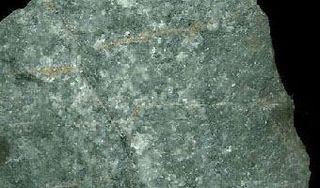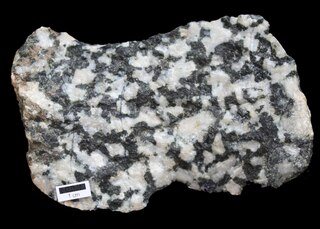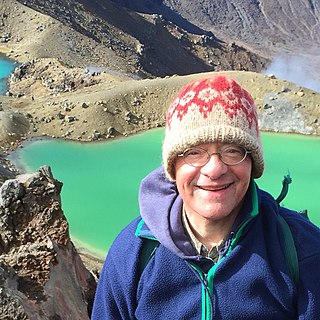Related Research Articles

Dacite is a volcanic rock formed by rapid solidification of lava that is high in silica and low in alkali metal oxides. It has a fine-grained (aphanitic) to porphyritic texture and is intermediate in composition between andesite and rhyolite. It is composed predominantly of plagioclase feldspar and quartz.

Andesite is a volcanic rock of intermediate composition. In a general sense, it is the intermediate type between silica-poor basalt and silica-rich rhyolite. It is fine-grained (aphanitic) to porphyritic in texture, and is composed predominantly of sodium-rich plagioclase plus pyroxene or hornblende.

Diorite is an intrusive igneous rock formed by the slow cooling underground of magma that has a moderate content of silica and a relatively low content of alkali metals. It is intermediate in composition between low-silica (mafic) gabbro and high-silica (felsic) granite.

A magma chamber is a large pool of liquid rock beneath the surface of the Earth. The molten rock, or magma, in such a chamber is less dense than the surrounding country rock, which produces buoyant forces on the magma that tend to drive it upwards. If the magma finds a path to the surface, then the result will be a volcanic eruption; consequently, many volcanoes are situated over magma chambers. These chambers are hard to detect deep within the Earth, and therefore most of those known are close to the surface, commonly between 1 km and 10 km down.

Komatiite is a type of ultramafic mantle-derived volcanic rock defined as having crystallised from a lava of at least 18 wt% magnesium oxide (MgO). It is classified as a 'picritic rock'. Komatiites have low silicon, potassium and aluminium, and high to extremely high magnesium content. Komatiite was named for its type locality along the Komati River in South Africa, and frequently displays spinifex texture composed of large dendritic plates of olivine and pyroxene.

Cumulate rocks are igneous rocks formed by the accumulation of crystals from a magma either by settling or floating. Cumulate rocks are named according to their texture; cumulate texture is diagnostic of the conditions of formation of this group of igneous rocks. Cumulates can be deposited on top of other older cumulates of different composition and colour, typically giving the cumulate rock a layered or banded appearance.
In geology, igneous differentiation, or magmatic differentiation, is an umbrella term for the various processes by which magmas undergo bulk chemical change during the partial melting process, cooling, emplacement, or eruption. The sequence of magmas produced by igneous differentiation is known as a magma series.

Fractional crystallization, or crystal fractionation, is one of the most important geochemical and physical processes operating within crust and mantle of a rocky planetary body, such as the Earth. It is important in the formation of igneous rocks because it is one of the main processes of magmatic differentiation. Fractional crystallization is also important in the formation of sedimentary evaporite rocks.
Jonathan David Blundy FRS is Royal Society Research Professor at the School of Earth Sciences at the University of Oxford and honorary professor at the University of Bristol.

A melt inclusion is a small parcel or "blobs" of melt(s) that is entrapped by crystals growing in magma and eventually forming igneous rocks. In many respects it is analogous to a fluid inclusion within magmatic hydrothermal systems. Melt inclusions tend to be microscopic in size and can be analyzed for volatile contents that are used to interpret trapping pressures of the melt at depth.
Hawaiite is an olivine basalt with a composition between alkali basalt and mugearite. It was first used as a name for some lavas found on the island of Hawaii.
Magmatic water, also known as juvenile water, is an aqueous phase in equilibrium with minerals that have been dissolved by magma deep within the Earth's crust and is released to the atmosphere during a volcanic eruption. It plays a key role in assessing the crystallization of igneous rocks, particularly silicates, as well as the rheology and evolution of magma chambers. Magma is composed of minerals, crystals and volatiles in varying relative natural abundance. Magmatic differentiation varies significantly based on various factors, most notably the presence of water. An abundance of volatiles within magma chambers decreases viscosity and leads to the formation of minerals bearing halogens, including chloride and hydroxide groups. In addition, the relative abundance of volatiles varies within basaltic, andesitic, and rhyolitic magma chambers, leading to some volcanoes being exceedingly more explosive than others. Magmatic water is practically insoluble in silicate melts but has demonstrated the highest solubility within rhyolitic melts. An abundance of magmatic water has been shown to lead to high-grade deformation, altering the amount of δ18O and δ2H within host rocks.

Basaltic andesite is a volcanic rock that is intermediate in composition between basalt and andesite. It is composed predominantly of augite and plagioclase. Basaltic andesite can be found in volcanoes around the world, including in Central America and the Andes of South America.

A subduction zone is a region of the earth's crust where one tectonic plate moves under another tectonic plate; oceanic crust gets recycled back into the mantle and continental crust gets created by the formation of arc magmas. Arc magmas account for more than 20% of terrestrially produced magmas and are produced by the dehydration of minerals within the subducting slab as it descends into the mantle and are accreted onto the base of the overriding continental plate. Subduction zones host a unique variety of rock types created by the high-pressure, low-temperature conditions a subducting slab encounters during its descent. The metamorphic conditions the slab passes through in this process creates and destroys water bearing (hydrous) mineral phases, releasing water into the mantle. This water lowers the melting point of mantle rock, initiating melting. Understanding the timing and conditions in which these dehydration reactions occur, is key to interpreting mantle melting, volcanic arc magmatism, and the formation of continental crust.

Mark S. Ghiorso is an American geochemist who resides in Seattle, Washington. He is best known for creating MELTS, a software tool for thermodynamic modeling of phase equilibria in magmatic systems.
Ian Stuart Edward Carmichael, was a British-born American igneous petrologist and volcanologist who established extensive quantitative methods for research in the thermodynamics of magmas.
Anat Shahar is a staff scientist at the Earth and Planets Laboratory, Carnegie Institution of Washington and adjunct professor at the University of Maryland. Her work uses high-pressure, high-temperature experiments and stable isotope geochemistry to understand the formation of planets in the Solar System.
The Achala Batholith is a group of plutons in the Sierras de Córdoba in central Argentina. With a mapped surface of over 2500 km2 it constitutes the largest group of intrusions exposed in the Sierras Pampeanas. The oldest reference to the batholith dates to 1932.

Patricia Martin Dove is an American geochemist. She is a university distinguished professor and the C.P. Miles Professor of Science at Virginia Tech with appointments in the department of geosciences and department of chemistry. Her research focuses on the kinetics and thermodynamics of mineral reactions with aqueous solutions in biogeochemical systems. Much of her work is on crystal nucleation and growth during biomineralization and biomaterial synthesis. She was elected a member of the National Academy of Sciences (NAS) in 2012 and currently serves as chair of Class I, Physical and Mathematical Sciences.
Edward Wesley Hildreth III, is an American field geologist and volcanologist employed by the United States Geological Survey (USGS). He is a fellow of both the Geological Society of America (GSA), and the American Geophysical Union (AGU). Hildreth was described as "one of the great volcanologists/petrologists of our time" in the magazine Wired.
References
- 1 2 3 Rebecca Lange publications indexed by Google Scholar
- 1 2 Lange, Rebecca Ann (1989). I. Properties of silicate liquids: volume and redox state : II. The association of Lamprophyres and Basaltic Andesites in Western Mexico. berkeley.edu (PhD thesis). OCLC 85015291.
- ↑ "Member Directory". sigmaxi.org. Retrieved 2019-05-28.
- ↑ Sanders, Robert (2011-09-15). "UC Berkeley volcano expert Ian Carmichael has died at 81". news.berkeley.edu. Berkeley News. Retrieved 2019-05-28.
- ↑ Carmichael, Ian S. E.; Lange, Rebecca A. (1996). "The Aurora volcanic field, California-Nevada: oxygen fugacity constraints on the development of andesitic magma" (PDF). Contributions to Mineralogy and Petrology. 125 (2–3): 167–185. Bibcode:1996CoMP..125..167L. doi:10.1007/s004100050214. hdl: 2027.42/42219 . S2CID 42283326.

- ↑ Lange, Rebecca A.; Navrotsky, Alexandra (1992). "Heat capacities of Fe2O3-bearing silicate liquids". Contributions to Mineralogy and Petrology. 110 (2): 311–320. doi:10.1007/BF00310746. hdl: 2027.42/47298 . ISSN 1432-0967. S2CID 55291947.

- 1 2 "Rebecca Lange | U-M LSA Earth and Environmental Sciences". lsa.umich.edu. Retrieved 2019-05-28.
- ↑ Lange, Rebecca A.; Ochs, Frederick A. (1999). "The Density of Hydrous Magmatic Liquids". Science. 283 (5406): 1314–1317. Bibcode:1999Sci...283.1314O. doi:10.1126/science.283.5406.1314. ISSN 0036-8075. PMID 10037599.

- 1 2 Hector, Jacob; Frey, Holli M.; Lange, Rebecca A. (2009). "A thermodynamic model for the plagioclase-liquid hygrometer/thermometer". American Mineralogist. 94 (4): 494–506. Bibcode:2009AmMin..94..494L. doi:10.2138/am.2009.3011. ISSN 0003-004X. S2CID 97746531.

- ↑ "Personnel Archive - 2013 | Geochemical Society". geochemsoc.org. Retrieved 2019-05-28.
- ↑ "Class of 1923 Memorial Teaching Award and John Dewey Award | U-M LSA U-M College of LSA". lsa.umich.edu. Retrieved 2019-05-28.
- ↑ "Geochemical Society" (PDF). elementsmagazine.org. Elements Magazine. Retrieved 2019-05-28.
- ↑ "Mineralogical Society of America - Past MSA Officers and Councillors". minsocam.org. Retrieved 2019-05-28.